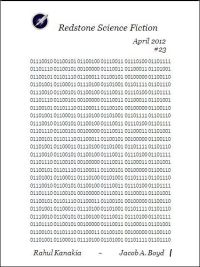 Redstone Science Fiction #23, March 2012
Redstone Science Fiction #23, March 2012
“An Early Adoption” by Rahul Kanakia
“Men and Their Toy” by Jacob A. Boyd
Reviewed by Matthew Nadelhaft
The latest issue of Redstone Science Fiction contains, as always, two stories. While I understand the difficulty of assembling and producing a larger periodical, especially one meant for online reading, I’m still not convinced publishing just one or two stories per issue is a wise move. There’s too much pressure on them to be brilliant; one weak story ruins your product for the month and two mediocre stories doesn’t come over much better. It can happen; writer and editors can all have off days.
This month’s Redstone is, sadly, a case in point. Neither story is dreadful, but neither is excellent, either. The first tale, “An Early Adoption” by Rahul Kanakia, does show promise in the way it pursues an almost overdone premise. Most of the human race in Kanakia’s story live their lives completely online – they have “uploaded” into a shared virtual reality. Their reasons for doing so and the mechanism by which it was accomplished are ignored, and rightly so. Kanakia has a far more interesting premise to examine. The story explores the daily life of this virtual environment’s inhabitants, the transformations friendship and social interactions undergo when shifted from a world of bodies into a world of thought. The prose is a confusing bombardment of imagery, as I imagine it was intended to be, in attempting to describe a world made up of the sum total of all its inhabitants’ imaginations. You know the family in your neighbourhood who always go completely apeshit with the Christmas decorations? Well, imagine them with the ability to construct their own virtual environment. The narrator, a staid woman (“I was so tempted to stay here and optimize my chilies”) is invited to a dinner party hosted by some newcomers to the virtual world, and their garish displays traumatize her. Unfortunately, it doesn’t go much further than that: the narrator’s peevishness left me unable to discern the extent to which the story was the start of what could have been a fascinating examination of the social mores of a shared, constructed reality, and how much of it was just a judgmental narrator with tacky friends. To understand how this story falls short one only has to imagine what Philip K. Dick might have done with the same conundrum.
Jacob A. Boyd’s “Men and Their Toy” likewise tries to pursue a hackneyed theme down a new trail. Dolly is a “toy,” a robot built to pleasure rich men. Not an outrageously novel concept, no. The story’s twist is its focus on the efforts of a vile gangster named Tersk to possess Dolly, killing every competitor to have owned her before him. Dolly’s previous owners were business rivals to Tersk and it’s not clear if Dolly is just part of the spoils of, or the prime motivation for, their murders. But Tersk, who is clearly incapable of having a relationship of his own, is not so much infatuated with Dolly as he is by all the men who owned her before, by what their relationships could have been, and he makes her describe each previous owner in chunks of dialog that almost come across as a collection of inter-related flash-fiction, preventing the story from building any kind of flow. The “sex-droid” as surrogate is nothing new to science fiction, nor is the theme of woman as trophy and loot. (Notice how I didn’t use the word “booty?” Until now.) What is unusual about this story is exactly what kind of surrogate role Dolly performs for Tersk; sex and violence are linked, through Dolly, in a homoerotic fantasy about power and the men he’s killed. All of which would be interesting, if the story were more tightly constructed.